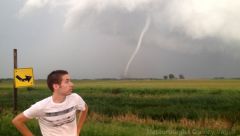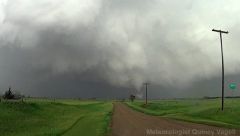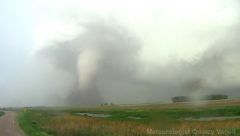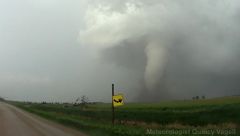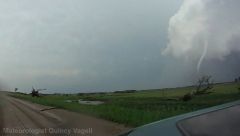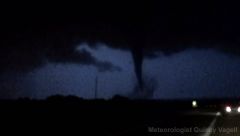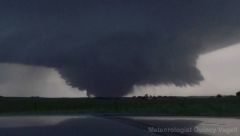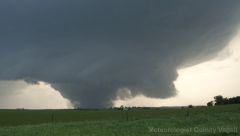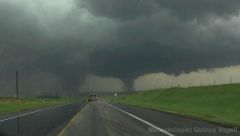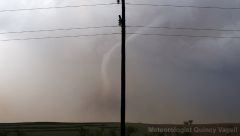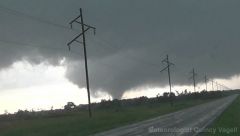-
Posts
6,220 -
Joined
-
Last visited
Content Type
Profiles
Blogs
Forums
American Weather
Media Demo
Store
Gallery
Everything posted by Quincy
-

Central/Western Medium-Long Range Discussion
Quincy replied to andyhb's topic in Central/Western States
00z NAM is awfully bullish now for Tuesday as well as Wednesday. Not sure how serious to take it, especially when it's showing a warm front all the way back into Nebraska Wednesday afternoon. Unless the GFS/Euro ramp up, may have to toss the NAM yet again. -

Central/Western Medium-Long Range Discussion
Quincy replied to andyhb's topic in Central/Western States
It's looking like a relatively small area across southeastern Kansas and far northern Oklahoma will see a somewhat favorable overlap of instability, forcing and wind shear on Wednesday. With that said, as mentioned earlier, there are still some red flags that we may be looking at another underperforming setup. While the GFS and Euro both show a surface low near the OK/KS border Wednesday afternoon and some backing low-level winds near a quasi warm front, we're just looking at a 1002mb low. Nothing like the more dynamic systems we saw last fall. While there's some moisture, the model consensus is only for mid-60s dew-points. The GFS spitting out some dews around 70 in the warm sector is likely overdone. We're looking at a relatively broad trough with no well defined shortwave energy being focused on one area. While the upper level flow is decent and the risk area is placed on the right-front jet quad, the low and mid-level winds aren't terribly impressive either, A few pieces there and and a few others likely lacking. Should still be interesting, but again, over a small area and the severity of any storms may be limited by several factors. Thursday looks to have more instability, but the shear pattern becomes more perpendicular to the front. Then, the trend continues to be toward a cold front or elongated low working as the main forcing mechanism. -

Central/Western Medium-Long Range Discussion
Quincy replied to andyhb's topic in Central/Western States
-

Central/Western Medium-Long Range Discussion
Quincy replied to andyhb's topic in Central/Western States
Still need some pieces to come together better than advertised on the Euro/GFS, but can't help but think that Wednesday into Thursday of next week has some potential from Oklahoma/Kansas into the mid-Mississippi valley. With a fairly deep trough digging, it's going to come down to timing of shortwave energy, surface low development/placement and richness of low-level moisture. Right now, the GFS shows a marginal setup with a strung out low, while the Euro is a bit more robust and shows a nice low-level jet ramping up. Let's see how the forecast evolves this weekend. -

Central/Western Medium-Long Range Discussion
Quincy replied to andyhb's topic in Central/Western States
Both the NAM and GFS look highly impressive for northern Iowa into southern Minnesota. Some may discount the NAM based off how it has handled some severe events this season, but even the GFS is spitting out some pretty significant values. Just pull a sounding for north-central Iowa and the GFS is showing over 200 m2s-2 0-1km helicity with 40+ knots of shear and a 40+ knot LLJ. Even seeing some STP values over 6 there on the GFS. (NAM is maxed out over southern Minnesota with double digit STPs) Caveats: Capping and lack of a trigger. The GFS/NAM combo does show a subtle piece of energy swinging through southern Minnesota, but one has to imagine that the threat near and south of the IA/MA border may be minimal to cap-busted. -

Central/Western Medium-Long Range Discussion
Quincy replied to andyhb's topic in Central/Western States
As mentioned, the timing for Wednesday/Thursday may be a bit off, but the parameters look awfully impressive for Wednesday. If the shortwave can speed up or we can otherwise get some more forcing in, that could kick off a few monsters. Thursday is probably out of reach, unless the whole thing slowed down. As advertised, Thursday would be a relatively narrow corridor of strong instability, but the kinematic support is lacking, along with an increasingly unidirectional shear pattern. It's into weenie-range, but the GFS/Euro also show a potent shortwave across the Dakotas/upper Midwest by next Monday/Tuesday. -

Central/Western Medium-Long Range Discussion
Quincy replied to andyhb's topic in Central/Western States
Based on fairly good model agreement at this point, it's looking quite interesting late next week/next weekend as well. A vigorous trough across the NW... The setup is somewhat reminiscent of June 16-18th, although the southeast ridge is a bit more prominent. It's way too early for specifics, but has my attention. -

Central/Western Medium-Long Range Discussion
Quincy replied to andyhb's topic in Central/Western States
The Euro indicates some severe risk for Sunday into Monday across the Plains and perhaps extending into the lower Missouri/upper Mississippi Valley regions. With an upper level trough digging, an increasing low-level jet and one or more surface lows developing along a front, there could be some potential. The GFS also points at an increasing threat at this time frame. A lot can change, but it's worth keeping an eye on. -

Central/Western Medium-Long Range Discussion
Quincy replied to andyhb's topic in Central/Western States
Some similarities to June 17th especially, at least given the slow/lazy storm motion and proximity to the NE/SD border. 00z NAM and GFS are still onboard. They're actually in fairly good agreement with the severe parameters near the warm front in southeastern SD by mid to late afternoon. Strong turning in the lowest 1-1.5km, a weakening cap and plenty of instability - assuming there's at least some clearing during the day. Both the GFS and NAM are showing >200 m2/s2 0-3km and >100 m2/s2 0-1km helicity. This combined with 30-40 knots (or more) of shear and as mentioned, there could be significant severe. I'm very interested to see the HRRR come into range. The 4km NAM simulated reflectivity shows a somewhat messy storm mode firing around 7-8 p.m. Will the window be that narrow/will initiation be that late? We'll see how the high resolution models trend. Either way, it's looking very interesting from far northeastern Nebraska into southeastern South Dakota, up to about or just north of I-90. Even the forecast soundings for KFSD look impressive with enlarged hodographs. Intriguing for any time of the year, but especially for August. -
There was a lot of anticipation leading up to July 15th. Some argued there was a "very impressive" severe setup unfolding for (southern) New England, but there was plenty of disagreement with the placement and potential severity of such an event. For a quick summary, the severe weather parameters in place (both forecast prior and during) the event were marginal compared to past severe events in southern New England. Not one important severe weather parameter was terribly impressive and there were many pieces to the puzzle that were missing here. As of July 17th, there have only been a handful of severe wind reports, centered over a small geographical area between far northeastern Massachusetts and adjacent far southeastern New Hampshire. There were a few damaging wind reports in downeast Maine, along with two marginally severe hail reports. Although there were several tornado warnings in the area, only one tornado has been confirmed so far. That was an EF-1 in Somerset County, Maine. (this blog post will be edited if any additional tornadoes are confirmed) Flooding was more of a widespread issue across much of New England and extending down into the NYC metropolitan area and New Jersey. There are some misconceptions as to what constitutes as a “significant” or “impressive” severe setup in New England. Generally almost all significant severe outbreaks occur with a west to northwest flow aloft and an anomalously strong overlap of shear (speed and directional) and instability. While it’s not uncommon to see strong instability and significant wind shear in this part of the country, they don’t often coincide with each other. There are other setups too, which are usually more marginal, sporadic and difficult to forecast. While some southwest to southerly flow events have produced severe, unless key ingredients are in place, those events usually only result in widely scattered or isolated severe reports. This event was well-modeled in the synoptic view. There was an anomalously strong upper level cutoff low moving into the Great Lakes. Ahead of this feature, there was a surface cold front advancing through Pennsylvania and New York with a pre-frontal/lee-side surface trough axis across New England by the morning of July 15th. While this may sound like a good setup, as often is the case in this part of the country, many additional things have to line up just right. If one or two (or more) variables don’t pan out right, then the whole setup will likely underperform compared to expectations. Timing was also another issue, as with the cutoff low displaced so far west from New England, the best forcing would also remain further west. The mesoscale models were predicting anywhere from 500 to 1,250 J/kg of MLCAPE (with somewhat greater SBCAPE) coinciding with 30-40 knots of bulk shear across central New England and portions of western southern New England. While both parameters are what can be considered “elevated,” they are on the low end (lower 50 percentile) for what has been observed in the Northeast in prior tornado cases. When looking at severe producing supercells in general (all types/modes), the values mentioned above are actually even less significant. Consider that the mean bulk shear value for supercells in the southwestern New England window* is 44 knots with a mean MLCAPE value of 1,421 J/kg. So, there were two key parameters in place that were elevated, but not terribly impressive in comparison to past severe events. There is another piece here that made the whole setup look even more marginal. Storm relative helicity or SRH (effective) was very meager on the computer forecast models for July 15th across most of the area. The progs were only between about 50 and 100 m2/s2. This is again on the low end, when considering that the mean SRH value for tornado and supercell cases alike in the area is 139 m2/s2 (which some cases over 300 m2/s2). While looking at this forecast setup from a strict numerical standpoint, while the threat of tornadoes and other severe weather were somewhat elevated, it was clearly a “below average,” or in other terms, an “unimpressive” setup. As far as the model simulated radar guidance, the NAM struggled to develop much in the way of discrete cell activity across southern New England, instead favoring a line of thunderstorms moving in from eastern New York by late afternoon and evening with stronger forcing ahead of the cold front. The HRRR was a bit more alarming, with a line strong to severe cells and clusters moving into southwestern New England by late afternoon. The HRRR by the 11z and 12z runs were showing some weak convection along the pre-frontal trough giving way to stronger convection further west later on. The morning of July 15th: Convection was already firing along the pre-frontal trough by midday, but due in part to limited heating, and weak forcing, the activity across Connecticut and south-central Massachusetts never reached severe limits. The HRRR continued to show stronger activity later in the day, but later runs gradually backed off on that idea. It was clear from the start that there was also a fairly unidirectional shear pattern with not much backing of low-level winds. Surface observations through the entire event, including the early to mid morning hours, showed surface winds S to SW. It cannot be overlooked that a small area from northeastern Massachusetts into southeastern New Hampshire and much of Maine did see scattered strong to severe thunderstorms develop later on during the afternoon. Analyzing the severe weather parameters on July 15th: The models did a good job of predicting wind shear, as the SPC mesoscale analysis showed an average of about 40 knots of bulk shear across the area, with more across northern and northwestern sections and less across southern and southeastern sections. MLCAPE was also close to model guidance with generally 1,000 J/kg, on average. The pre-frontal activity did decrease instability across Connecticut with a noticeable uptick in CIN, especially in the vicinity of the trough. It was across northeastern Massachusetts and points northwest where less CIN and more significant SBCAPE values supported more in the way of storms being able to reach marginally severe limits. Taking a step back, the mid-level lapse rates were fairly unimpressive across the area and this was acknowledged by SPC leading up to the event. The reanalysis showed lapse rates of 5.5 C/km or less across much of southern New England, with some lapse rates over 6 C/km across Maine. Upper level considerations: Analogs very strongly favored a relatively low-end severe event, especially given the position of the upper level low and the fact that the flow aloft was out of the SW. The RAP analysis from July 15th shows that the most significant vortmax was located very close to the upper level low, which was west of even western New York. There was some positive vorticity advection across northern New England, which likely was a factor in boosting some of the severe thunderstorms north and northwest of Boston, Mass. The mesoanalysis showed a weak, elongated vortmax between 18z on the 15th and 00z on the 16th, but this was up across northern Vermont and the northwestern Maine/Canada border. Finally, when also looking at the upper level flow, it was once again below climo levels with respect to significant severe events. The GYX and OKX soundings showed just 40 knots and 39 knots respectively of 500mb flow at 12z on the 15th. The upper level flow actually decreased notably at OKX to 31 knots by 00z on the 16th. While severe events can occur in the Northeast with limited upper level flow, the more impressive events typically have much stronger flow aloft. It should also be mentioned that the 850mb jet was unimpressive, with wind speeds of just 20 to 30 knots. Only one run of the Euro showed a signal of a strong jet and that was 144 hours prior, when it was predicting 45-55+ knots of 850mb flow. The relatively weak flow and generally unidirectional shear pattern can be seen clearly in the 12z July 15th OKX sounding: Considering the mesoscale models: The HRRR performed poorly on the larger scale, as it did not show pre-frontal activity contaminating the environment across southwestern New England. Instead, it was more optimistic in terms of severe and even showed somewhat alarming significant tornado parameter values over 1 across much of Connecticut. Although some convection did cross over from Long Island into Connecticut, this wasn’t until late at night and most of that activity was marginally severe or below severe limits. Some fairly weak storms did fire across eastern New York by late afternoon, but those merged with other convection to form a very messy storm mode, one that favored training of heavy rains and flash flooding. The models also showed more backing of low-level winds than what was observed on the morning of July 15th and through the event. In summary, what went wrong? While it’s easy to blame the entire bust on early day convection across Connecticut, consider again the forecast parameters in place that verified very closely to the actual analysis. Instability was somewhat elevated, but still modest at best with around 1,000 J/kg of MLCAPE. Shear was also elevated, but 40 knots of bulk shear is somewhat below the average for past severe cases. One of the most glaring parameters missing from the equation was helicity. Helicity was expected and verified to be quite low on the spectrum, with 100 m2/s2 at best, while tornado activity favors more than that. With a SW flow aloft, a more strongly backed low-level wind profile would have supported a greater threat of severe. Instead, any backing was minimal, with the mean low-level wind flow being S to SW. It would have been one thing if mid-level lapse rates were impressive, to offset some of the other marginal parameters, but 5.5 C/km is not going to make up for everything else. *
-

June 16-18 Tornado Outbreak
Images added to a gallery album owned by Quincy in Members Albums Category
Here are some images from the tornado outbreak that affected portions of the Upper Plains with several violent tornadoes from June 16th-18th of 2014. Some are photos and others are screen-grabs from video. -
From the album: June 16-18 Tornado Outbreak
I stand for a picture with a tornado in Alpena, SD, just a few minutes before it roped out. -
From the album: June 16-18 Tornado Outbreak
The tornado that tracked from Lane to Alpena, SD can be seen here near the beginning of its cycle. -
From the album: June 16-18 Tornado Outbreak
The Alpena tornado appears fairly large at this point. -
From the album: June 16-18 Tornado Outbreak
The Alpena tornado spins in a field next to a twisted road sign. -
From the album: June 16-18 Tornado Outbreak
A violent tornado near the end of its cycle in Alpena, SD on June 18th. A few uprooted trees can be seen in the foreground. -
From the album: June 16-18 Tornado Outbreak
On June 17th, several tornadoes continued into the night, not far from Laurel, NE. -
From the album: June 16-18 Tornado Outbreak
The tornado mentioned previously in Laurel appeared to have multiple vortices at times. -
From the album: June 16-18 Tornado Outbreak
A series of tornadoes tracked erratically on June 17th from the late afternoon hours and lasted well into the evening. This was most likely the first of this family of tornadoes, a wedge in the vicinity of Laurel, NE, -
From the album: June 16-18 Tornado Outbreak
My view of the icon and historic twin tornadoes in the vicinity of Pilger, NE. -
From the album: June 16-18 Tornado Outbreak
The first tornado was just beginning to rope out at this point. A short time later a wedge tornado dropped about 90 degrees to the right. A second wedge would form minutes later just to the right of that vantage point... -
From the album: June 16-18 Tornado Outbreak
The first of a family of violent tornadoes touches down in Stanton, NE on June 16th. This is within a minute or so after the tornado first touched down. -
Here are some filtered snowfall maps that I created using reports from various sources. Many of the reports came from this forum and the National Weather Service. Only social media reports that passed through quality control were considered. After early afternoon highs in the lower 60s across much of Connecticut on April 15th, a strong cold front moved through the area at night. Rain quickly changed to sleet and snow across the higher elevations of western Connecticut between 8 and 11 p.m. Although a changeover eventually took place from west to east across most of the state, the heaviest snow fell across western Connecticut. Snow ended before the pre-dawn hours on the 16th. Snowfall amounts of 1 to 2″ were common across northern Fairfield and Litchfield Counties. Although there was a gap in the data, it is possible that there were more reports of greater than 2″ across the Litchfield Hills. With this relatively small sample, the highest amounts were from Redding to Roxbury with 2 to 3″ or so. The radar image above left shows a band of heavy snow across northwestern Connecticut shortly after 12:30 a.m. on the 16th. As of 2 p.m. on April 16th, temperatures across the higher terrain in western Connecticut were only in the mid to upper 30s. As is often the case with early spring snowfalls, unseasonably cold air followed the snow. Here is a black and white version of the map: Click here for a complete list of snowfall totals used in these maps.
-
Following up a cold winter across much of the country, April has proven to be a transition month. Although the month started mild for a large portion of the country, much cooler air has moved in for the middle of the month. There are signs, however, that any negative temperature departures after April 20th into the start of May will be relatively insignificant. Before looking at May, it makes sense to look at the April forecast. For the most part, everything is going to plan from the forecast that was made on March 15th. Although portions of the Northeast have been milder than forecast for the month as a whole, one and perhaps two shots of cool air to finish the second half of April will likely counteract the present offsets. As far as the models go, the Euro MJO prediction of moving into phase 2 and 3 verified very well, although the MJO has since looped back around into phase 5 an 6. Click here for a follow-up to the April forecast. Going forward, there continue to be signs of the remnant winter pattern of troughs across the East Coast breaking down. The Euro shows no clear move with the MJO, although it tries to keep it in the vicinity of phases 4-6 to even neutral. Each of those phases would suggest near to slightly above average temperatures for much of the center and eastern portion of the country with slightly below average temperatures across portions of New England. The GFS ensembles move toward phase 8 and 1, suggesting more of a northern Plains warm-up with near to even below average temperatures near the Gulf States. With no strong signals with respect to the MJO, focus shifts toward the Euro and CFS. The Euro weeklies show a fairly zonal pattern with only near to slightly above average temperatures for much of the area. Much like the MJO projections, such a pattern could yield near average temperatures across the Gulf States. The CFS is robust with warming across the upper Plains and yields near to slightly above average temperatures for most other areas. While the CFS keeps the upper Great Lakes below average, this may be overdone due to below average water temperatures. Final considerations and forecast: The thinking is that the persistant drought across the desert Southwest and adjacent lower Plains will continue. This will especially be the case if the CFS is correct with pronounced ridging in the area. The dry soil will tend to favor above average daytime temperatures. So while there may only be substantial confidence in slightly above average temperatures in the range of 1 to 2F across the mid-Mississippi and Ohio Valleys, a +2 to +3F anomaly forecast has been introduced for portions of the western lower Plains. Ridging could extend into the Great Lakes, but still below average water temperatures should mitigate any warming, especially downwind of a prevailing west-southwest flow. There is moderate confidence in some cooler than average temperatures hanging on across northeast New England, so a small area of -1 to -2F anomalies are included for Maine. Severe thunderstorms: A forecast graphic is not being made for this outlook with respect to severe thunderstorms. The year 2014 continues to follow a near-record low number of severe thunderstorm events and tornadoes. A series of severe weather events, which may or may not be significant, are possible between April 23rd and 25th. Beyond that, a fairly zonal flow with some above average heights in the Plains and Midwest does not look overly impressive for severe activity. However, the pattern will favor at least an increase to near average activity through the month of May. In summary, the severe thunderstorm forecast is close to climatology and has little confidence in specifics. Prior years that saw very low activity through mid-April did see an increase in activity by late April. A close analog to 2014 is 2010. That season saw an uptick in severe reports between the end of April and through the month of May.
-
Severe thunderstorms are likely today across portions of the Plains and Mississippi River Valley. Ongoing thunderstorms early this morning may be marginally severe across portions of Iowa, northern Missouri and Illinois. Additional showers and thunderstorms are likely from late morning into the early afternoon hours further south before a more serious threat develops. Sunday afternoon, low pressure will be in the vicinity of the central border between Texas and Oklahoma. An upper level shortwave will begin to rotate through the area with a vortmax swinging into eastern Oklahoma. Thunderstorms will likely fire just ahead of a dryline during the afternoon hours. These thunderstorms can explosively develop, producing large hail, damaging winds and at least a few tornadoes. The greatest potential for tornadoes will be from extreme northeast Texas into eastern Oklahoma. There is some uncertainty with respect to how far north this threat will extend, but the area south of the KS/OK/MO tri-state border has the highest probability of seeing tornadoes. There is high confidence that there will be numerous severe reports, but it is not clear over how large of an area the most intense storms will extend. Climatology suggests that the tornado threat could extend further east into Arkansas and southern Missouri late Sunday night into early Monday. Although this is possible, a loss of heating and a cold front overtaking the dryline should mitigate the risk after 12 a.m. Monday.





